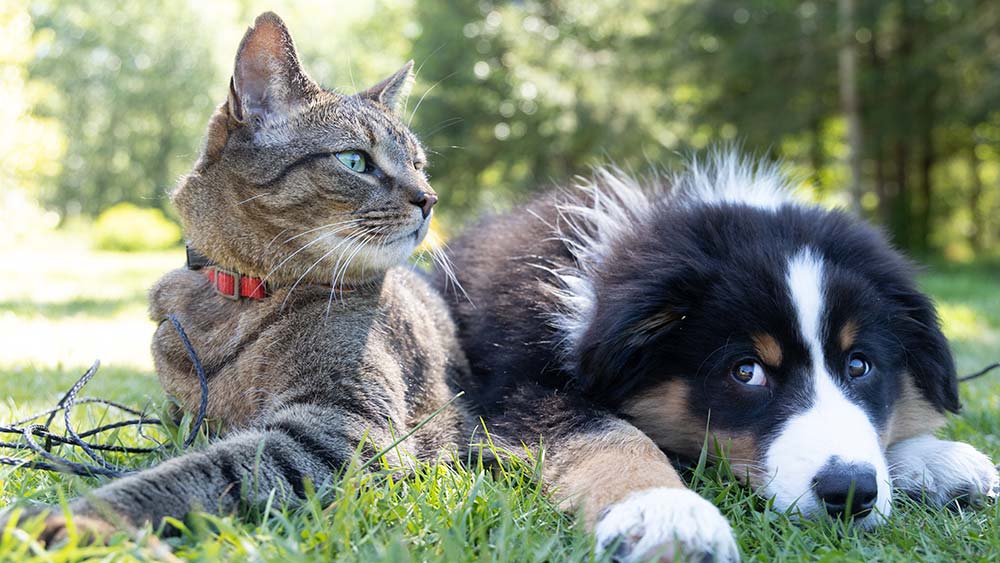Vitamin D (a fat-soluble vitamin) is needed for proper absorption of calcium and phosphorus from the intestinal tract. It is needed for normal growth and development of bones and teeth, protects against muscle weakness, and regulates the heart. Vitamin D helps prevent hypocalcemia and osteoporosis, enhance immunity, and is needed for proper thyroid function and blood clotting.
Vitamin D in food or supplements is converted into an active form by ultraviolet light from the sun acting on the vitamin D precursor located in the skin, and then metabolism by the liver and kidney.
Vitamin D is both a vitamin and a hormone. It is a vitamin because your pet’s body cannot absorb calcium without it; it’s a hormone because your pet’s body manufactures it in response to the skin’s exposure to sunlight. Processed foods contain enough vitamin D and do not need supplementation; homemade diets contain adequate vitamin D due to the recommendation for supplementation with vitamin supplements.
There are two major forms of vitamin D, and both have the word calciferol in their names (in Latin, calciferol means “calcium carrier”). Vitamin D3 is made by the body and is found in some foods. Vitamin D2 is the form most often added to milk and other foods, and the form most likely to be included in synthetic supplements; it is also the form found in plants.
Therapeutic Uses
Vitamin D promotes the intestinal absorption of calcium and subsequent urinary calcium excretion. Reducing dietary phosphorus increases activation of vitamin D, which promotes more intestinal absorption of calcium and urinary calcium excretion. Pets with oxalate urinary (bladder) stones should not be fed diets with restricted levels of dietary phosphorus for this reason.
Vitamin D supplementation is not usually needed as part of a holistic treatment for pets, as vitamin D deficiency is unlikely to occur (unless it occurs as part of calcium deficiency due to the interaction of these compounds). In people, there is reasonably good evidence that the combination of vitamin D and calcium supplements can be quite helpful for preventing and treating osteoporosis (an extremely unlikely disease in most pets). Vitamin D deficiency causes a bone disorder called rickets and osteomalacia. Vitamin D toxicity results in calcification of blood vessels and organs.
Vitamin D and the Skin
Vitamin D is the only vitamin that can be produced in the skin. In the epidermis (outer layer of skin), vitamin D3 (cholecalciferol) is formed from pro-vitamin D3 (7-dehydrocholesterol) on exposure to sunlight. The cholecalciferol is then transported to the circulation from the skin via the vitamin D-binding protein in plasma. Cholecalciferol is then transported to the liver where it is hydroxylated to 25-hydroxyvitamin D3, transported to the kidney, and hydroxylated in 12,25-dihydrovitamin D3, which is used in the regulation in the proliferation and differentiation of the epidermis.
In people, exposure to sunlight provides adequate levels of vitamin D. However, recent research suggests that dogs and cats have low levels of vitamin D activation by UV-B light due to low levels of vitamin D in the skin, indicating that supplementation of vitamin D may be needed.
Sources
Fish liver oil (cod liver oil), cold water fish (such as mackerel, salmon, and herring), butter, egg yolks, dairy products, liver, oatmeal, and sweet potatoes are good sources of vitamin D. Most vegetables provide little vitamin D, but dark green leafy vegetables do contain some. Also green foods and herbs, including horsetail and nettle, contain vitamin D.
Scientific Evidence
Some evidence suggests that vitamin D may help prevent cancer of the breast, colon, pancreas, and prostate, but the research on this question has yielded mixed results. Vitamin D is sometimes mentioned as a treatment for psoriasis. However, this recommendation is based on Danish studies using calcipotriol, a variation of vitamin D3 that is used externally (applied to the skin).
Today, severe vitamin D deficiency in people is rare in the developed world. However, it is sometimes seen in elderly people who don’t get enough sunlight. Marginal vitamin D deficiency may also occur in people who live in northern latitudes and don’t drink vitamin D-enriched milk. Additionally, carbamazepine, phenytoin, primidone and phenobarbital (for seizure), corticosteroids, cimetidine (for ulcers), colestipol and cholestyramine (older drugs used for lowering cholesterol), and the antituberculois drug isoniazid (INH) may interfere with vitamin D absorption or activity.
It is unlikely for most pets to develop vitamin D deficiency. Reptiles most commonly develop vitamin D and calcium deficiency due to lack of vitamin D and calcium in the diet, as well as lack of exposure to UV light.
Dosages
AAFCO recommendations for dietary vitamin D are 500 IU/ kg of food for dogs (maintenance, growth, and reproduction) and 500 IU/kg of food (maintenance) to 750 IU/kg of food (reproduction) for cats. Kittens seem to require 250 IU/kg of food, which is less than the current AAFCO recommendations of 750 IU/kg of food.
Safety Issues
When taken at recommended dosages, vitamin D appears to be safe. However, when taken to excess, vitamin D can build up in the body and cause severe symptoms of toxicity. In people, toxic symptoms (ranging from headaches, weight loss, and kidney stone, to deafness, blindness and death) are seen when dosages above 1200 mg daily are taken for long periods of time.
In pets, vitamin D levels should not exceed 10,000 IU/kg of food, although some brands of moist foods exceed this level.
People with sarcoidosis or hyperparathyroidism should never take vitamin D without first consulting a physician. Pets do not get sarcoidosis; however, similar precautions are probably warranted in pets with hyperparathyroidism when taking vitamin D supplements.
Vitamin D toxicity will not occur when using whole food sources rather than synthetic forms of vitamin D.
In people taking anti-seizure drugs (carbamazepine, phenobarbital, primidone, valproic acid or phenytoin), corticosteroids, Coumadin (warfarin), H2 blockers (Zantac, for example), heparin , isoniazid (INH), rifampin, verapamil, or the older cholesterol-lowering drugs colestipol and cholestyramine, there may be a need for extra vitamin D. The same need may also apply to pets, although this has not been well researched and most doctors do not give additional vitamin D to pets taking these medications.
Vitamin D toxicity can occur in pets. The D3 form appears to be more toxic than the D2 form. In reptiles, vitamin D toxicity commonly occurs due to over-supplementation by owners.
In dogs and cats, vitamin D toxicity most commonly results from poisoning with vitamin D rodenticides (rat poison). These poisons cause increased levels of blood calcium that can be fatal.












